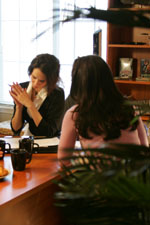.
Workmans Compensation | Insurance Glossary | Insuring Your Business
Safety In The Work Place
Its important to train staff in the areas of safety in the workplace. Show everyone where the first aid kit and the fire extinguisher are. Make sure all dining room and kitchen staff can perform the Heimlich maneuver on a choking person.
Safety Tips
All emergency telephone numbers should be POSTED at all times. This list includes police, fire department, ambulance, health department, and food poison control center phone numbers .
Hang a poster of first aid for choking next to the phone.
Place a first aid Kit and fire extinguisher within easy reach.
Have a fire drill. Your staff need to be able to help guests to get out of the building safely in case of a crisis.
Burn Safety
When removing lids from steaming, pots, pans, and kettles, watch for hot steam and hot lids.
Do not use wet potholders when handling hot pans. Make sure they are flame resistant.
The handles of pans should be turned inward on range so that they cannot be bumped off.
Keep flammable materials such as papers, plastic aprons, etc. away from heat and hot areas.
Make sure your pots and pans have sturdy handles.
Warn co-workers when you are coming up behind them with something sharp.
Tell the pot washer when pots, pans and handles are hot.
Use only dry side towels for handling hot items.
Preventing Falls
Step ladders should be in good repair. Never use a chair, box, or counter top to reach things up high.
Keep flooring in good repair and clean up grease spills as they occur. You can use salt or cornmeal to absorb the grease and then clean the area.
Keep all work areas well lit.
Use caution signs for wet floor areas.
Make sure tables and chairs are durable and sturdy.
Pick up anything on the floor that might trip someone.
Cuts
Place knives and other sharp utensils in a holder or appropriate place, never loose in a drawer with other utensils.
Never cut towards the body and never point a knife at another person. When walking with a knife in a crowded kitchen, carry the knife with the blade pointing down and facing backward.
Throw all broken dishes and objects away.
Wash all sharp tools separately from other utensils.
When washing dishes, never put sharp objects in the bottom of sink. Knives can sometimes become entangled in dish clothes and cause cuts.
Fire Safety
Keep fire extinguishers serviced and in convenient locations. Make sure everyone knows where they are and how to use them.
Keep water away from electrical outlets.
Make sure all equipment is up to code. Frayed or exposed wires and faulty plugs can cause a fire. Do not over-burden outlets.
Never try to put out a grease, chemical or electrical fire by throwing water on the flames.
Chemical Safety
Store all poisons away from food to avoid cross contamination.
Mark all chemicals clearly.
Use only food safe products when cleaning food prep areas.
Dress Safely
A double breasted chef's jacket creates a two layer cloth barrier between the chest area and steam burns.
Long sleeves protect the arms against burns and scalding splashes.
Long pants are best to protect the legs from burns and should not have cuffs, which can trap hot liquids and debris.
Pants should have a snap fly, no belt in case hot grease is spilled on them the cook can get out of them quickly.
Hats prevent sweat and hair from falling into the food.
Hard leather shoes that can protect the toes from sharp falling objects are important. They should have slip resistant soles.
Aprons are to protect your clothes from stains and not wipe your hands on.

|
